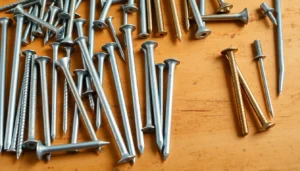Capacitors might not be the stars of the electronic world, but they sure know how to steal the show when it comes to energy storage and management. These tiny components play a pivotal role in everything from your smartphone to your favorite gaming console. Understanding their characteristics can turn you into the superhero of your own tech adventures.
Table of Contents
ToggleOverview of Capacitor Characteristics
Capacitors exhibit several key characteristics that define their performance and suitability for various applications. Capacitance, measured in Farads, indicates the capacity of a capacitor to store electrical charge. This measurement reflects the amount of energy the capacitor can hold, making it essential for power management and energy storage tasks.
Voltage rating represents the maximum voltage a capacitor can safely handle. Exceeding this rating risks damage or failure. Factors such as temperature and frequency can influence performance and lifespan.
Equivalent series resistance (ESR) quantifies the internal resistance that adds to energy loss during operation. Lower ESR values indicate better efficiency, making capacitors with low ESR preferable for high-frequency applications.
Tolerance indicates the deviation range of capacitance from its specified value. For example, a capacitor with a tolerance of ±10% can vary by 10% from its marked capacitance. Understanding tolerance assists in ensuring circuit reliability.
Temperature coefficient describes how capacitance changes with temperature variations. This characteristic is crucial for applications in environments subjected to fluctuating temperatures. Capacitors with a stable temperature coefficient maintain consistent performance.
Leakage current represents unintended current flow through the capacitor when it’s uncharged. Lower leakage current values are desirable, particularly in energy-sensitive applications.
Dielectric type influences various characteristics, including capacitance, voltage rating, and temperature stability. Different applications warrant specific dielectric materials, such as ceramic, electrolytic, or tantalum.
Familiarity with these capacitor characteristics helps individuals select the right components for their electronic projects, enhancing overall circuit functionality and reliability.
Types of Capacitors
Understanding different types of capacitors enhances knowledge about their specific applications and performance characteristics. Each type serves distinct functions in electronic circuits.
Ceramic Capacitors
Ceramic capacitors, commonly used for decoupling and filtering, offer high stability and reliability. They feature a dielectric made from ceramic materials, which allows them to operate effectively in varying temperatures. Commonly found in small electronic devices, these capacitors provide good capacitance per unit volume, making them ideal for compact designs. Ratings typically range from a few picofarads to several microfarads. Due to their low equivalent series resistance, ceramic capacitors excel in high-frequency applications.
Electrolytic Capacitors
Electrolytic capacitors have polarized designs that allow them to achieve high capacitance values in compact sizes. They utilize an electrolytic solution as the dielectric, which enables greater capacitance compared to other types. Often applied in power supply circuits, they handle high voltage and smoothing applications efficiently. Their capacitance values commonly range from 1 microfarad to several thousand microfarads. However, users should consider the performance drop at higher frequencies and increased leakage currents over time.
Film Capacitors
Film capacitors are known for their longevity and stable electrical properties. They utilize a thin plastic film as the dielectric, which contributes to low distortion and high insulation resistance. Typically used in audio applications, they provide clarity in signal transmission. Capacitance values for these capacitors generally span from nanofarads to microfarads. Moreover, film capacitors perform well in high-frequency environments and are available in various configurations, such as metallized or non-metallized options.
Key Electrical Characteristics
Capacitor characteristics play a vital role in determining their effectiveness in various applications. Understanding these specific attributes enhances component selection for electronic projects.
Capacitance
Capacitance defines a capacitor’s ability to store electrical energy. Measured in farads (F), this value indicates the potential energy available for a circuit. Smaller capacitors often have capacitance values in microfarads (µF) or picofarads (pF), while larger ones reach millifarads (mF) and beyond. Applications dictate the required capacitance; for instance, decoupling capacitors usually possess low capacitance values, whereas power supply filters engage with higher values. Selecting the right capacitance ensures optimal circuit functionality.
Voltage Rating
Voltage rating specifies the maximum voltage a capacitor can handle without risking breakdown. Designers need to stay below this threshold to avoid component failure. Ratings appear in volts (V) and vary considerably among capacitor types. Ceramic capacitors usually offer higher voltage ratings compared to electrolytic types. It’s essential to consider operational and transient voltages when determining the needed rating. Exceeding the specified voltage can lead to operational failure and damage to the circuit.
Equivalent Series Resistance (ESR)
Equivalent series resistance (ESR) measures a capacitor’s internal resistance when an AC signal is applied. Optimal performance occurs when ESR is low, which minimizes energy losses during operation. Capacitors with high ESR can cause heat build-up and reduced efficiency in power applications. The design of the capacitor influences ESR values; for example, tantalum capacitors typically exhibit lower ESR than ceramic types. In high-frequency applications, selecting a capacitor with low ESR proves vital for maintaining stability and efficiency.
Physical Characteristics
Capacitors exhibit unique physical characteristics that significantly impact their performance and application in electronic circuits.
Size and Form Factor
Capacitor size and form factor vary significantly, influencing their integration into designs. Miniature capacitors, such as surface mount devices (SMD), fit compact circuit layouts, while larger electrolytic capacitors are preferred for power applications due to their higher capacitance values. Form factors like cylindrical and rectangular shapes accommodate different circuit configurations. Some capacitors even feature specialized enclosures, enhancing durability. Designers often prioritize size to meet specific space constraints; thus, selecting the right size impacts overall circuit efficiency and performance.
Temperature Rating
Temperature rating plays a critical role in capacitor reliability and longevity. Different dielectric materials yield varying temperature ranges, crucial for selecting capacitors in temperature-sensitive applications. For instance, ceramic capacitors typically withstand temperatures from -55°C to +125°C, offering versatility in diverse environments. Electrolytic capacitors, however, generally handle lower temperatures, often rated from -40°C to +85°C. Monitoring temperature ratings ensures capacitors function effectively under fluctuating conditions, maintaining stability in electronic circuits.
Applications of Capacitors
Capacitors play vital roles across various electronic applications. Power supply circuits utilize electrolytic capacitors due to their high capacitance values, essential for smoothing voltage variations. In audio systems, film capacitors provide stable electrical properties, ensuring sound fidelity and quality.
Ceramic capacitors find extensive use in decoupling and filtering within small electronic devices. With their reliability, they help maintain signal integrity in smartphones and gaming consoles. These components function effectively in high-frequency applications, making them suitable for RF circuits as well.
Timing applications often incorporate capacitors in conjunction with resistors to form RC timing circuits. These circuits leverage the charging and discharging properties of capacitors, enabling precise timing control in devices like digital clocks. Additionally, capacitors assist in energy storage applications, where they temporarily hold electrical energy for later use.
Automotive systems also benefit from capacitors. They manage energy in circuits responsible for lighting, ignition, and audio systems, contributing to overall vehicle performance. Capacitors in this context must withstand specific temperature ranges and vibrations that occur during operation.
Industrial machinery relies on capacitors for motor starting and running applications. High-capacitance capacitors boost performance in single-phase motors, helping them start smoothly and run efficiently. Their ability to handle high voltage and current levels adds reliability to these critical systems.
Medical devices utilize capacitors in various diagnostic and therapeutic applications. For example, they serve as timing elements in pacemakers and defibrillators, crucial for accurate operation. The distinct characteristics of capacitors enable their integration into life-saving technology, underscoring their significant impact.
Conclusion
Capacitors are integral components in modern electronics that significantly impact device performance and reliability. Their diverse characteristics and types allow for tailored applications across various technologies. By understanding factors like capacitance, voltage rating, and equivalent series resistance, individuals can make informed choices when selecting capacitors for their projects.
This knowledge not only enhances circuit functionality but also fosters a deeper appreciation for the technology that powers everyday devices. As electronics continue to evolve, the role of capacitors will remain vital, underscoring the importance of ongoing education in this field.





